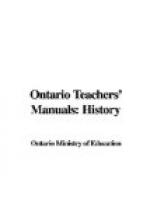Teacher.—Did
you notice the two places that were to be connected
by the road?
Pupil.—They were Halifax and the St. Lawrence River.
T.—Why do you think Halifax was chosen as one terminus?
P.—Because it is near the sea.
T.—Well, Quebec is not far from the sea either.
P.—It is the nearest port for ocean-going steamers.
T.—Do you know what happens to the St. Lawrence every winter?
P.—It freezes up.
T.—Yes. It is frozen over for about four months in the winter, and ocean-going vessels cannot use the river then, so Halifax was chosen as a good winter port on the Atlantic. Now, what place on the St. Lawrence would be chosen as the other terminus?
P.—Most likely either Quebec or Montreal.
T.—We can tell better a little later which one was actually chosen. Here is a thing that I want you to think about. Why should they build the railway just to the St. Lawrence? Were there many people living in Upper Canada fifty years ago?
P.—Yes, as many people as there were in Quebec province.
T.—Really
there were about 250,000 more here than in Quebec.
How
would the people here
ship their goods in the winter? How do we
send our goods to Europe
now in winter?
(Several suggestions
were made. Finally it was stated that we could
ship by water in summer,
and by rail in winter.)
T.—You
know that there are some rapids on the St. Lawrence
before we reach Montreal.
How do we manage about them?
P.—By using the canals.
T.—How can we ship by rail?
P.—By using the Grand Trunk or the Canadian Pacific Railway.
T.—Now, I shall have to tell you something about the canals and the first railway from Upper Canada. There were several canals already built on the St. Lawrence: the Lachine, Welland, and others. In fact, we had spent about $1,500,000 on canals before Confederation. The Grand Trunk Railway was running from Sarnia to Quebec city by 1856, just eleven years before Confederation. (Have a pupil trace the line from Sarnia to Quebec, so that the class may see how much of Upper Canada was served by the Grand Trunk.) Can you tell me now what place on the St. Lawrence would be taken as the western terminus of the new railway?
P.—Yes, Quebec would be the one.
T.—Why?
P.—Because
the people of Upper Canada had ways already for
sending their goods
as far as Quebec city.
T.—The
next point to think about is—How had Canada
been
shipping her goods across
the sea in winter before this?




